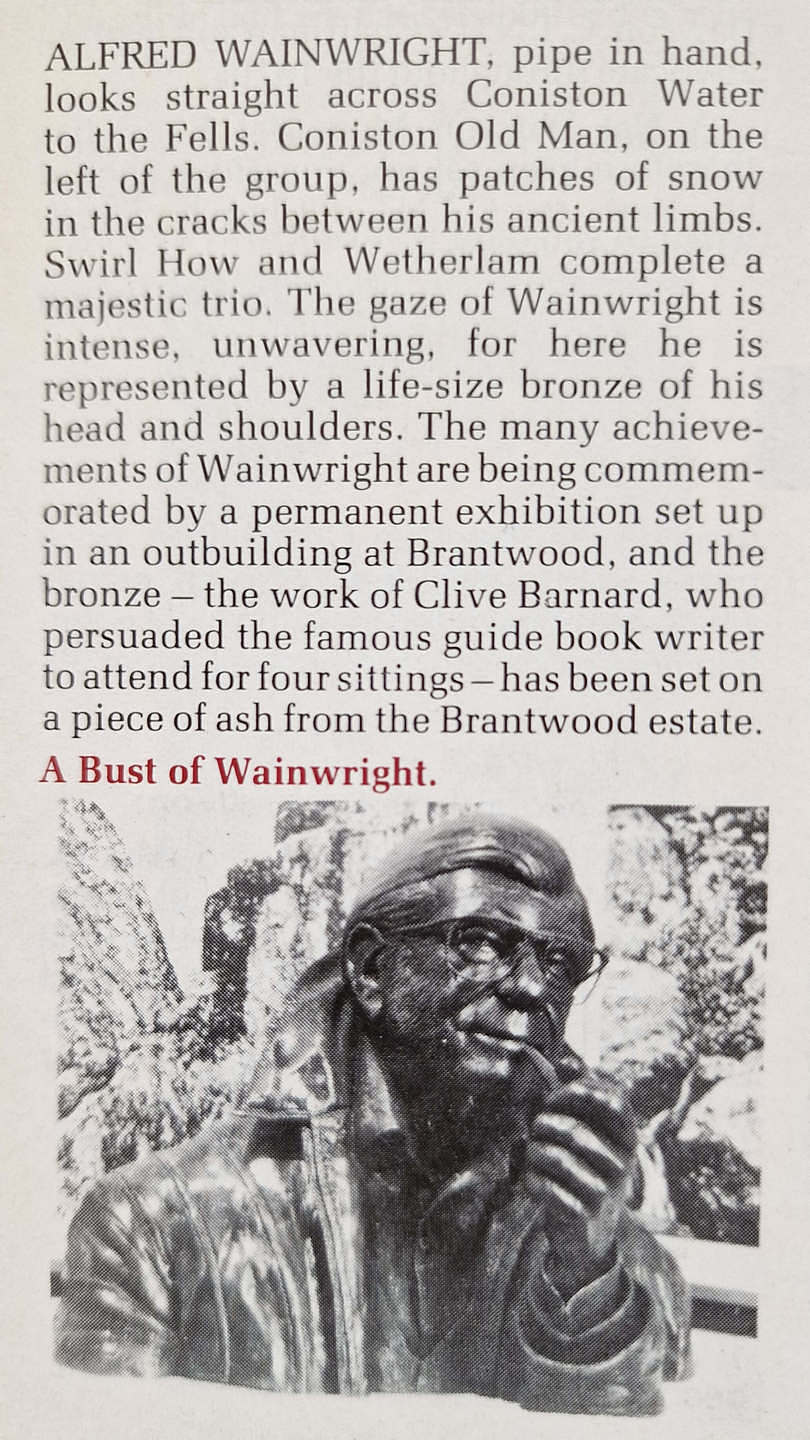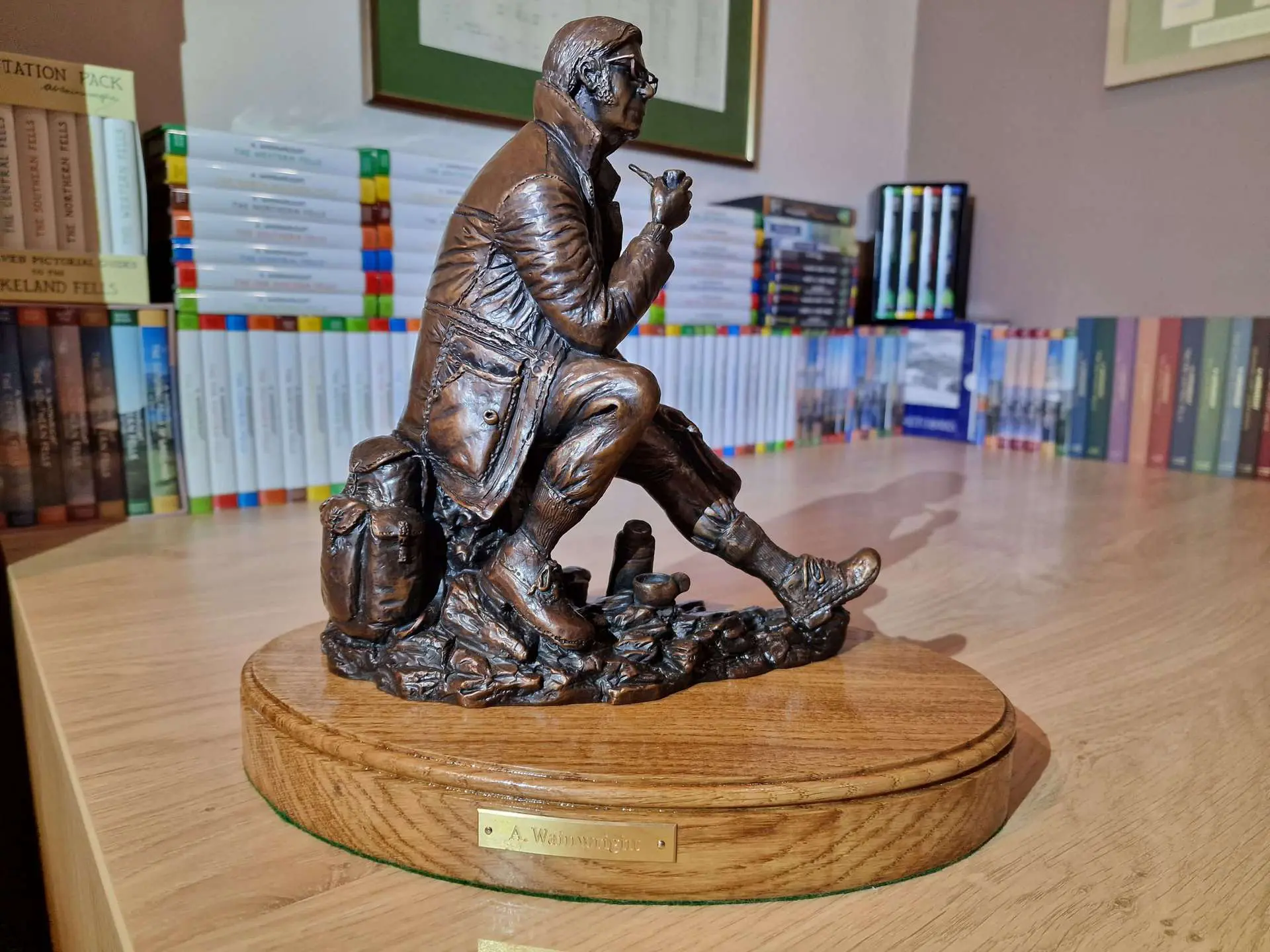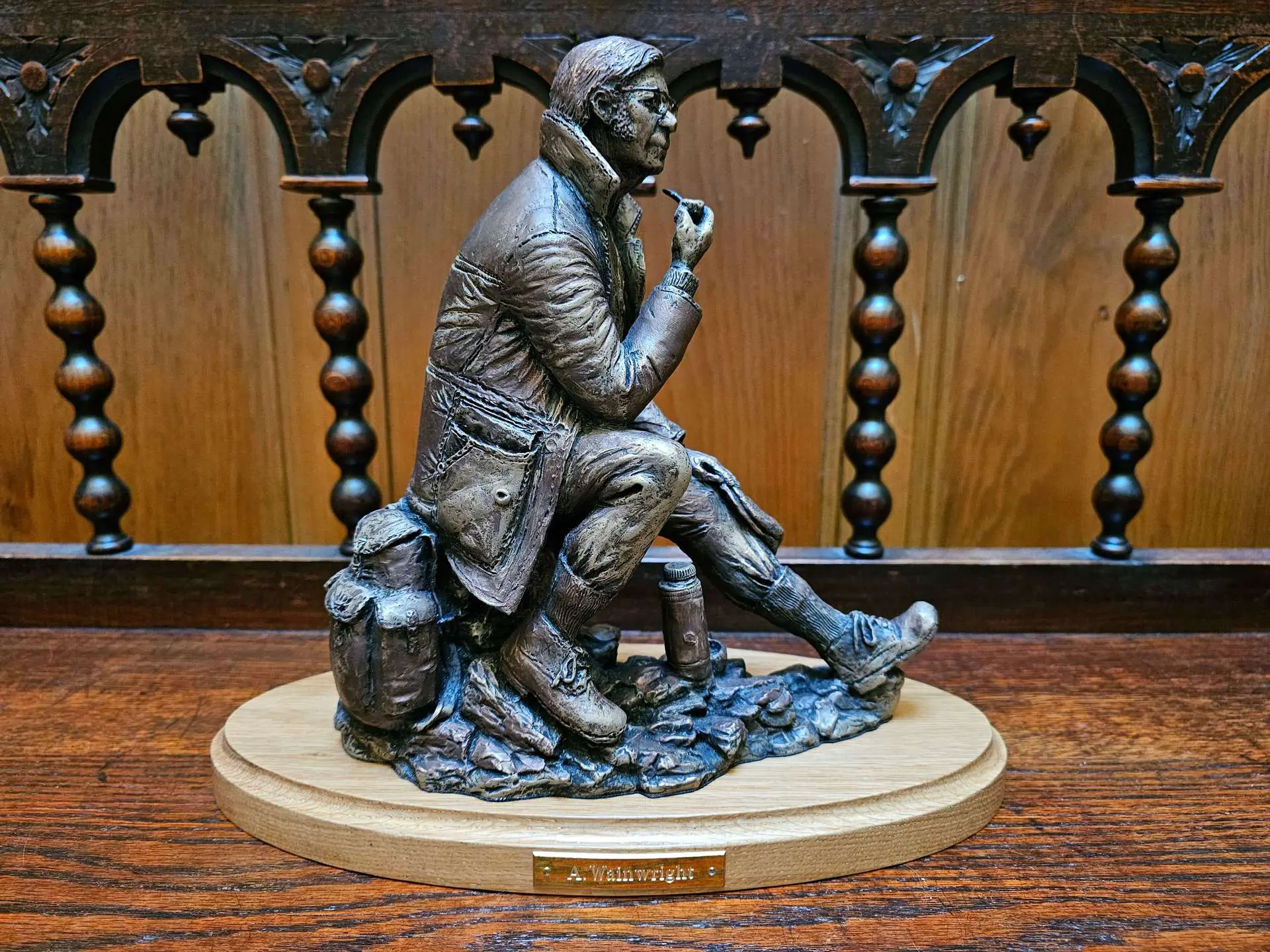The Wainwright Sculptures
Article by Chris Butterfield
I have spent the last few years connecting with people who knew Wainwright well. One such associate was sculptor Clive Barnard. He has produced sculptures for clients worldwide; many are well-known, such as Brian Blessed. In 1986, Clive was commissioned by the Westmorland Gazette to create a bronze bust of Wainwright, who explicitly chose Clive for the job. Andrew Nichol, former book publishing manager at the Gazette, drove Wainwright to a meeting with Clive. Before the meeting, Andrew gave Clive advice on what to say to be accepted by Wainwright. “Tell him you’re a walker and you’ve read all his books, then you’ll be fine,” he said.
The meeting went well, and although Wainwright initially wanted a full-size bust, he eventually agreed with Clive that focusing on just the head and shoulders would work better. As soon as Clive’s quote was accepted, the work could commence.


There were four sittings at Clive’s studio in Haverthwaite, and he remembers the time fondly. There was great banter between them, and Clive gave as good as he got. “It’s noon, and I normally have another cup of tea by now,“ said Wainwright. “Well, go make it then,” Clive retorted. Wainwright was a little shocked. “But I’m your client.” “Well, I’m the one who’s working; you’re sat there doing nothing.” “I don’t know how to take that,” replied Wainwright as he made his way to the kettle. Clive smiled.
Wainwright gave Clive his old pair of glasses and pipe to use as references for the sculpture. After several weeks, the bust was complete, and Wainwright was delighted with the finished piece, which now resides in Kendal Museum. He visited Clive many times following the work and made tea every time. They got on exceptionally well after they broke the ice, and every session was full of chat with plenty of humour.


In addition to the bust, Clive produced several small, detailed sculptures, which were Wainwright’s idea. He gave Clive sole permission to make them. Cumbria magazine advertised these detailed sculptures regularly during the late 1980s. They were expensive but popular with collectors. Tracking them down proved difficult, and it took me years to find one.

I met Clive in Lancashire a few months ago, and it was great to listen to him reminisce about his time with Wainwright. “It’s difficult for anyone to sit for a sculpture, and it must have been a new experience for him,“ said Clive. I mentioned the tea incident and asked if it was true. “Yes, it was. It backfired on me because the tea Wainwright made was awful, and I told him so,” chuckled Clive. He said that during the sessions, Wainwright’s son Peter would call in occasionally to chat with his dad. “It was good to see the bond between father and son.”
Clive showed me samples of his impressive work that spans decades, and I was fortunate to see Wainwright’s original pipe and glasses used during the Pictorial Guide years. Wainwright also gave Clive many photos to help with the small sculptures. One photo was taken in his study, him smiling toward the camera. Clive remembers Wainwright’s exact words when he handed them to him. “No one believes me, but this photo proves I smile.”


Clive was pleased with the growing Alfred Wainwright Books & Memorabilia community. Although he had retired many years ago, I asked him if a new sculpture was possible. Clive was delighted with my proposal, which gave him an excellent reason to come out of retirement. We decided upon two sculptures, with one being completely new. These would be the first created for over thirty years, and I gave Clive my own Wainwright sculpture to assist. I felt this project was important and would help keep Wainwright’s legacy in the public eye. Producing them is a long process, so it would be late 2022 before they were ready.




Clive held a grand draw at his Haverthwaite studio gallery in 1988. The tickets for the draw were £1 each, and all the proceeds went to Animal Rescue Cumbria. Many Wainwright-related items could be won, including a solid bronze Wainwright statue. The plaster cast of the original bust was also on display. Sheila Richardson, a friend of Wainwright, purchased one of the sculptures and had taken the following five photographs. Clive’s partner at the time, Lindsay Murray, appears in a couple.





On a visit to Kendal, I told Andrew Nichol that Clive was producing new sculptures, and he was delighted. This gave me the idea of reuniting these two gentlemen who hadn’t seen each other since the late 1980s. I arranged a surprise 90th birthday treat for Andrew at Clive’s house in Lancashire during the summer of 2022. Priscilla and I drove him there without telling him where he was going. Within the hour, we’d arrived, and Andrew was ecstatic at seeing Clive after all these years.

Clive’s wife Helen was a wonderful host and kindly laid on some delicious food, and Andrew and Clive exchanged many exciting and funny Wainwright stories from the past. Clive recalls an incident at his gallery in 1987. “I’ll always remember walking through the gallery, and you told me, I hope you are charging Wainwright enough. He’s got money coming out of his ears.” Andrew laughed and said, “Did he hear me?” “No,” replied Clive, “But you bent down and picked a fiver off the floor, then tapped him on the shoulder, and said, AW, you have dropped this, and then Wainwright turned around and asked where it came from, and you said your ears.”
After lunch, Andrew was shown the first sculpture made in plasticine and was blown away by the level of detail. He was also reunited with the clay sculpture of the life-size Wainwright bronze bust, which he hadn’t seen since he visited Clive’s studio in 1986. Seeing these two fine gentlemen chatting after nearly four decades apart was a privilege. It was a fantastic day, and I am sure that Wainwright would have been pleased his old friends were together again after all these years.



The below images are of the first Wainwright pattern that Clive has produced since the 1980s. The second sculpture was based on Clive’s very first bronze resin sculptures. Silicone moulds are then used to create the cast. Instead of a silicone mould, a 3D was sent to a foundry.




The lost wax method of casting dates from at least the 3rd millennium B.C., probably much earlier. This method produces hollow bronzes with thin walls and improves the quality of the casts. The lost wax casting process was invented to create the finest detail in a sculpture. It is still the most accurate and reliable means of producing complex shapes in metal castings containing all the detail of the original pattern. The main advantage is that it allows one to replicate the same object as often as required.
The process requires a silicone rubber mould to be made of the original artwork, capturing every detail of the original. This Master mould is used to produce wax copies of the original sculpture, and then, cups for pouring and rods that allow trapped air to escape are attached to the waxes. The waxes are then covered in a ceramic shell and fired. The wax is melted out (lost), and molten bronze, at 1200c, is poured in. The ceramic shell is broken off when cool, and the rods and cup are removed. A fixing plate to take a base is welded to the underside, and the scars are carefully blended to match the original sculpture as intended by the artist by the chaser.

The bronze is hand-polished in preparation for a patina or protective coating, and the wax coating is hand-applied and polished to a deep lustre. The bronze is first reheated during the patination process before an artist applies chemicals. The patination can achieve many different colours and effects that depend on the mix of chemicals used. Each process demands a very high skill level, taking generations to achieve. The sculpture is finely numbered, and the foundry mark is stamped in. The numbering of the piece is the order in which it was cast from the master mould, e.g., 1/50, the last number being the edition run before all moulds are destroyed.
In late December 2022, the sculptures were finally complete. Priscilla and I took Andrew to see Clive and Helen for the unveiling and a party to celebrate. The two sculptures are masterpieces and are a credit to Clive’s skill. It has been years since Clive produced a Wainwright sculpture, so working with him on two new ones was an honour.

The images below are of Clive’s brand-new sculpture. The pose was based on one of Wainwright’s self-portraits from the Pictorial Guides. This is the finest solid bronze Wainwright Clive has ever produced. This brand-new solid bronze Wainwright sculpture will be made to order as a limited edition of 50 and will come with a certificate of authenticity. It will be fixed to an attractive solid oak base with a nameplate to the side. The size, including the base, is 11.5″ x 6.5″ x 11″. These will be the final solid bronze sculptures ever produced by Clive. They will never lose value and should be considered an investment.


In addition, the new Wainwright sculpture was also produced in bronze resin. The sculpture will be made to order as a limited edition of 100 and comes complete with a certificate of authenticity. It will be fixed to an attractive solid oak base with a nameplate on the top (the square base has recently been upgraded to an oval base). The size, including the base, is 11.5” x 6” x 10”. These will be the final bronze resin sculptures ever produced by Clive.


The second sculpture is based on the first-ever Wainwright sculpture, originally made of bronze resin. This was Wainwright’s favourite sculpture, so Clive produced it in solid bronze for the first time. Again, this will be a limited edition of up to 50 sculptures. The size, including the base, is 12″ x 8″ x 10″. The following four images highlight the new sculpture alongside the original bronze resin sculpture produced in the mid-1980s. All three sculptures are available in the website shop.

To the right is the original bronze resin sculpture, which the solid bronze sculpture was based on.
<<>>
The Title photo is courtesy of Kendal Museum.
The Wainwright at Brantwood photo is courtesy of the Westmorland Gazette.
Clive’s sculptures are available in the Memorabilia section of the shop.


